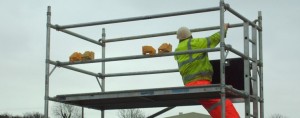Accidents at work represent a huge proportion of all injuries in the UK every year and some of them are fatal or life-changing. Falls from a height account in their turn for a large number of these accidents and rarely have a good outcome. At the very least they can result in broken bones or serious contusions; and their worst catastrophic head injuries which will cause problems for life, if they don’t prove fatal.
 This may sound melodramatic but the facts are clear – working at a height can be a dangerous business. Although accidents are not totally avoidable, they can be minimised by making sure all staff likely to be working at a height have full training in safety and working techniques and more importantly that this training is kept up to date. Even the most dangerous of working conditions can become commonplace if experienced every day and it is vital that no one becomes complacent.
This may sound melodramatic but the facts are clear – working at a height can be a dangerous business. Although accidents are not totally avoidable, they can be minimised by making sure all staff likely to be working at a height have full training in safety and working techniques and more importantly that this training is kept up to date. Even the most dangerous of working conditions can become commonplace if experienced every day and it is vital that no one becomes complacent.
A number of International Powered Access Federation (IPAF) courses are available nationally, but Boss Training believe that tailoring the courses specifically to one type of equipment is more likely to result in staff who are exceptionally well trained in what they use every day without being overburdened with knowledge they don’t need. An example of this precision delivered training is the IPAF training course, which is specific to that piece of equipment and makes sure that all issues to do with working at a height on a powered boom are covered, including the all-important emergency descent procedures.
Theory is all very well but nothing works quite so well as a practical session and this is why Boss can deliver the training in a company’s own workspace. Although everyone learns in different ways, it is an undoubted fact that it is easier to take things in when the environment is familiar and especially if it is delivered in the equipment the trainee uses every day. The information which the attendee will be given includes the all-important safe work procedures, emergency descent operations and an understanding of employers’ and employees’ responsibilities. It is easy to forget that part of the danger of working at height is what may happen to people on the ground – how to secure tools and warn those below is an important part of the training course.
There are many regulations governing the responsibilities of one worker towards him or herself and others, but the main topic of study for this course is the Health & Safety at Work Act 1974 with specific emphasis on the Work at Height Regulations. Boss Training does not just teach a worker to repeat parrot fashion, but endeavours to ensure that they know why they need to behave in a certain way – this is a better way of making sure procedures are followed. Mobile elevating work platforms (MEWPs) are all different and in their the employee is made aware of the capabilities and restrictions of the ones in use as well as how to do risk assessments of jobs, checks and inspections and simple maintenance to ensure safety. The session will end with a written and practical test, which makes sure that everything has been fully understood.
Related Stories:
- 10 essential training tips when working at height
- Risk assessment for working at height
- A guide to working at height training